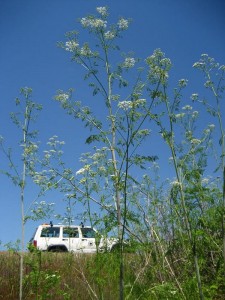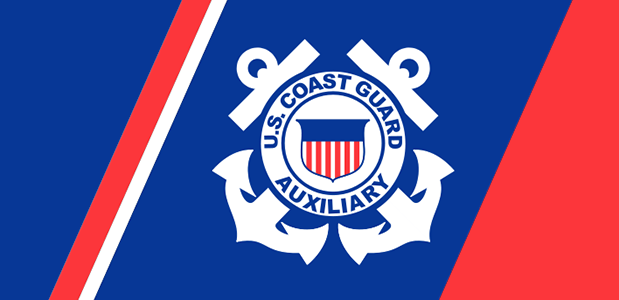
Poison Hemlock not only noxious, but deadly
By Alison Halpern, Executive Secretary, Washington State Noxious Weed Control Board
Poison hemlock (Conium maculatum), a poisonous weed to people and animals, can currently be found blooming all over Washington State. Last year, there were several cases of human ingestion or exposure to poison hemlock, with one resulting in the death of an adult, according to the Washington Poison Center. This was the first human fatality in Washington State since 1999. It is imperative to be able to identify poison hemlock to prevent accidental ingestion. It can be mistaken for many edible and ornamental members of the carrot family such as parsley, parsnip, wild carrot, and anise that have similar-looking flowers, leaves, and seeds.
Poison hemlock is a biennial plant that can grow very tall, reaching heights of four to nine feet. The hollow stem is smooth and hairless and has very distinctive purple blotches all over it. It has large, glossy green, finely divided, fern-like leaves that are smooth and hairless. Like many members of the carrot family, poison hemlock produces flat-topped flower arrangements consisting of small clusters of tiny, white flowers. Chemical compounds in poison hemlock give the entire plant – especially the leaves when crushed – an unpleasant odor that has been described as musky or resembling the smell of mouse urine. An aggressive invasive species, poison hemlock rapidly colonizes streambanks, vacant lots, roadsides, pastures, and meadows, especially where the soil is moist, outcompeting native plants and desirable forage species.
Poison hemlock contains toxic alkaloids, including coniine and γ-conicein, which are found in all plant parts but are most concentrated in unripe seeds. These poisonous compounds affect the nervous system. Initial symptoms may include a burning sensation in the mouth, nausea, vomiting, confusion, respiratory depression, and muscle paralysis. Death, when it occurs, is usually rapid and due to respiratory paralysis.
Due to its toxicity and invasiveness, poison hemlock is a listed Class B noxious weed in Washington. It is designated for control in many counties throughout the state, which means that landowners in these counties are required by law to control and prevent the spread of this noxious weed. However, because poison hemlock is so dangerous to have around, the state and county noxious weed control boards recommend controlling it wherever it grows. It is advisable to wear gloves and protective clothing, such as long sleeves, pants and eye protection, when removing poison hemlock to prevent accidental exposure to plant juices. Wash your hands after poison hemlock removal.
Small patches of poison hemlock can be dug up, making sure to remove the taproot. Do not cut or mow the plants, as they will only resprout. Herbicides containing the chemical glyphosate are readily available and can be very effective. Be sure to follow the label carefully. The best time to spray poison hemlock is when the leaves are just a basal rosette, and before it forms flowers; however, herbicide control work can be done whenever the plant is actively growing, prior to seed development. Remember that the toxins will remain potent in dried plant material so bag and trash dead plants. Never put pulled poison hemlock in the compost or leave them where children or livestock might eat them. Follow-up efforts will be necessary to control seedlings that may germinate at the site. Planting grasses or other desirable plants will provide competition and help prevent new poison hemlock plants from establishing.
Local county noxious weed control boards, WSU extension offices, and conservation districts can all provide assistance in identification and control of poison hemlock and other noxious and/or toxic weeds. Ingestion of poison hemlock should be taken seriously and persons having done so should be taken to the emergency room. For further information about poison hemlock poisoning and symptoms, contact the Washington Poison Center at 1-800-222-1222.
**If you are reading theOrcasonian for free, thank your fellow islanders. If you would like to support theOrcasonian CLICK HERE to set your modestly-priced, voluntary subscription. Otherwise, no worries; we’re happy to share with you.**







